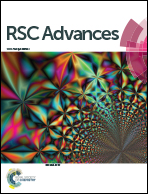The ‘CαNN’ motif: an intrinsic lover of sulfate and phosphate ions†
Abstract
The anion binding ‘CαNN’ motif, which is comprised of three consecutive amino acid residues, usually occurs in the protein loop regions preceding a helix. Recent computational work on the ‘CαNN’ motif present at the N-terminus of a series of context-free chimeric peptides hypothesizes that its interaction with anions (sulfate/phosphate), is locally-mediated. However, the effectiveness of the interaction depends on the sequence and the conformation of the motif as well as the nature of the anion. In order to substantiate the suppositions obtained from the in silico evidence regarding the affinity of the ‘CαNN’ motif towards anions, we have used complementary biophysical experiments to study the interaction of anions (sulfate and phosphate) with the ‘motif’ segments. Analyses of the results have clearly established that even in a non-proteinaceous, context-free system without any tertiary effect, the ‘CαNN’ motif can recognize the anions (both sulfate and phosphate) through local interactions along with augmentation of the helical conformation at the motif segment. However, the efficacy of the interaction depends on the motif sequence and the participating anion. These observations clearly establish the intrinsic affinity of the ‘CαNN’ motif for anions along with its sequence and conformational prerogatives towards recognition.


 Please wait while we load your content...
Please wait while we load your content...